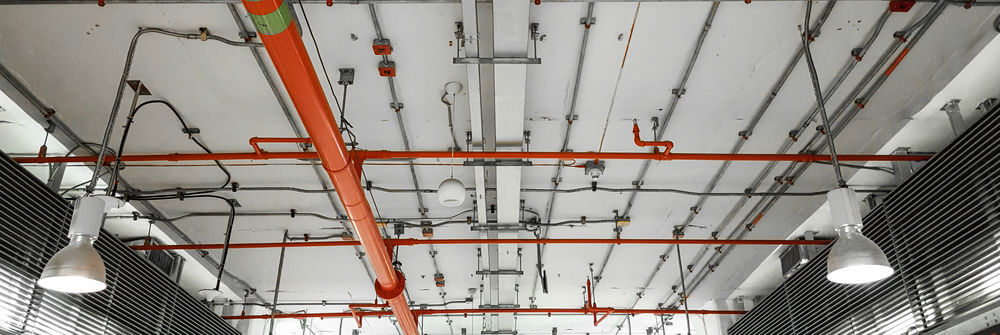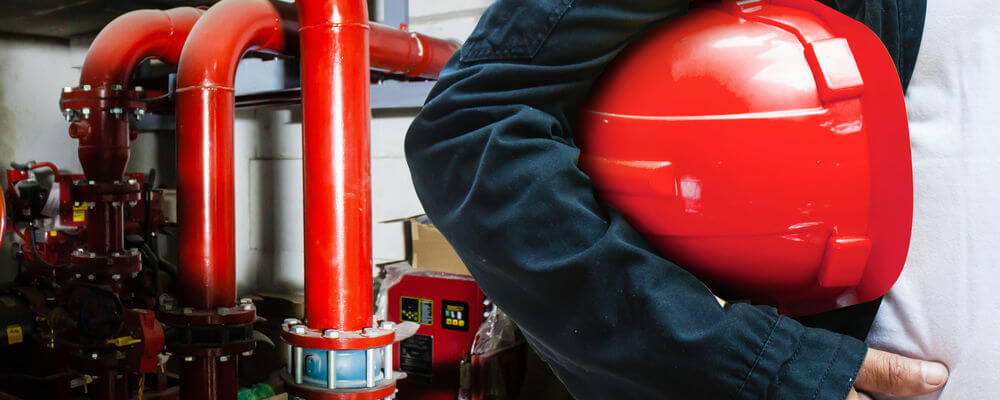Nitrogen Generator for Dry Sprinkler Systems
January 22, 2019
Sprinkler systems are a vital part of building safety and are often required under building codes. In the past, fire suppression sprinkler systems were wet systems- that is, systems where the water is contained within the pipes of the sprinkler system at all times. This type of system had several disadvantages, but the main problem was that the water was likely to leak.
Over time, wet systems are likely to experience drips or even have valves fail. Failure of wet sprinkler systems can cause water leakage and result in catastrophic damage to property within the building. These problems have led the switch from wet systems to dry sprinkler systems.

The Dangers of Sprinkler Pipe Corrosion
As long as there have been fire suppression sprinkler systems, there have been problems with corrosion. Corrosion gradually creates localized pinholes within the pipes which, if left unchecked, will lead to leaks and valve failures. Even sprinkler lines that don’t show external signs of leaking can be compromised to the point where they will not work in the event of a fire. Non-functioning sprinkler systems can allow minor fires to spread and can result in disastrous property and personnel losses.
Steel pipes are subject to corrosion and their deterioration process begins once the pipes are installed. While dry sprinkler systems don’t have the leakage issues experienced by wet systems, the dry fire protection systems are more prone to corrosion. Corrosion results when oxygen, metal, and water are brought together. In this combination, water provides the electrolytes, oxygen offers the electrochemical potential, and together they react with the unprotected metal. The solution might seem to be avoiding the use of metal pipes altogether. PVC pipes can be used in some settings but larger sprinkler systems require stronger steel pipes.
Even though dry sprinkler systems are “dry” they still have exposure to moisture in the air, which is enough water to lead to corrosion. They are only filled with water when the sprinklers have been activated. When the system is inert the pipes are filled with gas. In the past, dry systems were filled with air. This made them more prone to corrosion since the mixture of gases in the air allows condensation to form inside the pipes. The solution to this problem is to fill the pipes with nitrogen.
What Is a Nitrogen Fire Suppression System?
Nitrogen fire suppression systems are dry sprinkler systems filled with nitrogen rather than compressed air. Since nitrogen is inert, it does not provide an environment that is conducive to corrosion. There are no risks if the nitrogen leaks into the surrounding air.
Switching to a nitrogen gas fire suppression system instead of using compressed air may seem like a relatively small change but the difference in durability is dramatic. On average, air-filled dry sprinkler systems are expected to last 12-15 years. Nitrogen fire suppression systems can have a life expectancy of 60-75 years, depending on the type of piping materials used.
Galvanized pipe that is part of a nitrogen sprinkler system has an expected lifespan of 92 years compared to as little as 7 years in a compressed air system. Black steel piping can last 48 years in nitrogen systems instead of the 16 years for the air-filled system.
The use of a nitrogen-based sprinkler system results in a substantial difference in long-term replacement costs over the life of a building. In addition, corrosion-resistant nitrogen sprinkler systems eliminate the ongoing need to check for leaks and corrosion and make repairs. The extended lifespan provided by nitrogen can even make it practical to install less expensive black steel piping instead of galvanized pipes.
While best results are achieved by filling new systems with nitrogen, the lifespans of existing air-filled dry sprinkler systems can be extended by switching to nitrogen. Flushing out the compressed air and replacing it with nitrogen will retard corrosion to preserve the integrity of the pipes.

How Does a Nitrogen Dry Sprinkler System Work?
A nitrogen dry sprinkler system uses a series of piping to provide water when needed to extinguish a fire. The sprinkler lines are filled with nitrogen to prevent corrosion when not in use. This makes nitrogen sprinkler systems different from wet sprinkler systems that are filled with water and dry air sprinklers that are filled with compressed air.
Although nitrogen sprinkler systems can be filled using tanks of nitrogen, the preferred option is to use a nitrogen generator for fire sprinkler systems. These nitrogen generators produce nitrogen on site by extracting nitrogen from the air. Typically, an attached air compressor forces air into the generator where it passes through a membrane to extract the nitrogen.
Learn more about the operational benefits of a membrane nitrogen generator today.
Having an onsite nitrogen generator for fire protection is considerably more convenient than using tanks of nitrogen. Many building managers prefer not to have high-pressure tanks stored on site, and the use of tanks of nitrogen requires monitoring tank levels and scheduling deliveries. A nitrogen generator can be used to maintain the levels of nitrogen within the system with little maintenance required. Additionally, nitrogen generators are more cost-effective than nitrogen deliveries.
Nitrogen generator fire protection systems can also include the use of nitrogen pressure swing adsorption (PSA) systems. PSA technology is used to separate different types of gas under pressure. Adsorbent materials are used to trap the targeted gas at high pressure. Then a switch to low pressure results in the release of the gas by the absorbed material.
Two adsorbent vessels can be used together to provide near-continuous production of the target gas. As one vessel is depressurized to release the target gas, that pressure can be transferred to the other vessel. This reduces the amount of energy necessary to operate the PSA nitrogen generator and results in significant energy and cost savings. Learn more about the benefits of GENERON® PSA Nitrogen Generators today.
Keep in mind the importance of switching to nitrogen dry sprinkler systems as soon as possible to prevent corrosion and extend the useful life of your fire suppression system. Contact GENERON now to find out which nitrogen options will work best for you.
